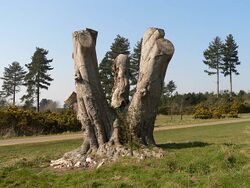Earth:Living stump
From HandWiki
Short description: Living root remains of a cut or otherwise dead tree
A living stump is created when a live tree is cut, burned, eaten, or infected, causing its cambium to die above the root system.
Living stumps are generally characterized as having a thin outer layer of living cells that surround a hollow central cavity. [1]
Living stumps can survive for several years by
- using excess carbon reserves,
- transfer of nutrients from the roots of neighbouring trees, often aided by mycorrhiza[2] or
- root grafting to the root system of living trees.
Root grafting allows for carbon transfer from living trees to living stumps resulting in incremental cambium growth in the stump.[3]
Stumps can grow a callus tissue over its cross section which prolongs longevity of the stump by protecting it from infection and insect damage.[4] A living stump which is capable of producing sprouts or cuttings is known as a stool, and is used in the coppicing method of woodland management.[5]
Common examples
- Pinus strobus (white pine)
- Castanea dentata (American chestnut)
- Tsuga spp. (hemlock)
- Pseudotsuga menziesii (Douglas-fir)
- Cedrus spp. (cedar)
References
- ↑ Davidson, Donald W. (1963). "Living Stumps of Tsuga canadensis (L.) Carr. (Hemlock) in Northern New Jersey". Bulletin of the Torrey Botanical Club 90 (3): 204–207. doi:10.2307/2482756.
- ↑ Simard, Suzanne W.; Perry, David A.; Jones, Melanie D.; Myrold, David D.; Durall, Daniel M.; Molina, Randy (1997). "Net transfer of carbon between ectomycorrhizal tree species in the field". Nature 388 (6642): 579–582. doi:10.1038/41557. Bibcode: 1997Natur.388..579S.
- ↑ Bormann, F.H.; Graham Jr., B.F. (1959). "The occurrence of natural root grafting in eastern white pine (Pinus strobus L.), and its ecological implications". Ecology 40 (4): 677–691. doi:10.2307/1929820.
- ↑ Lanner, Ronald M. (1961). "Living Stumps in the Sierra Nevada". Ecology 42 (1): 170–173. doi:10.2307/1933281.
- ↑ Crist, John B.; Mattson, James A.; Winsauer, Sharon A. 1983. Effect of severing method and stump height on coppice growth. In: Hansen, Edward A., ed. Intensive plantation culture: 12 years research. Gen. Tech. Rep. NC-91. St. Paul, MN: U.S. Department of Agriculture, Forest Service, North Central Forest Experiment Station: 58-6; retrieved on 2008-05-10 from www.treesearch.fs.fed.us/pubs/18839.
 |


